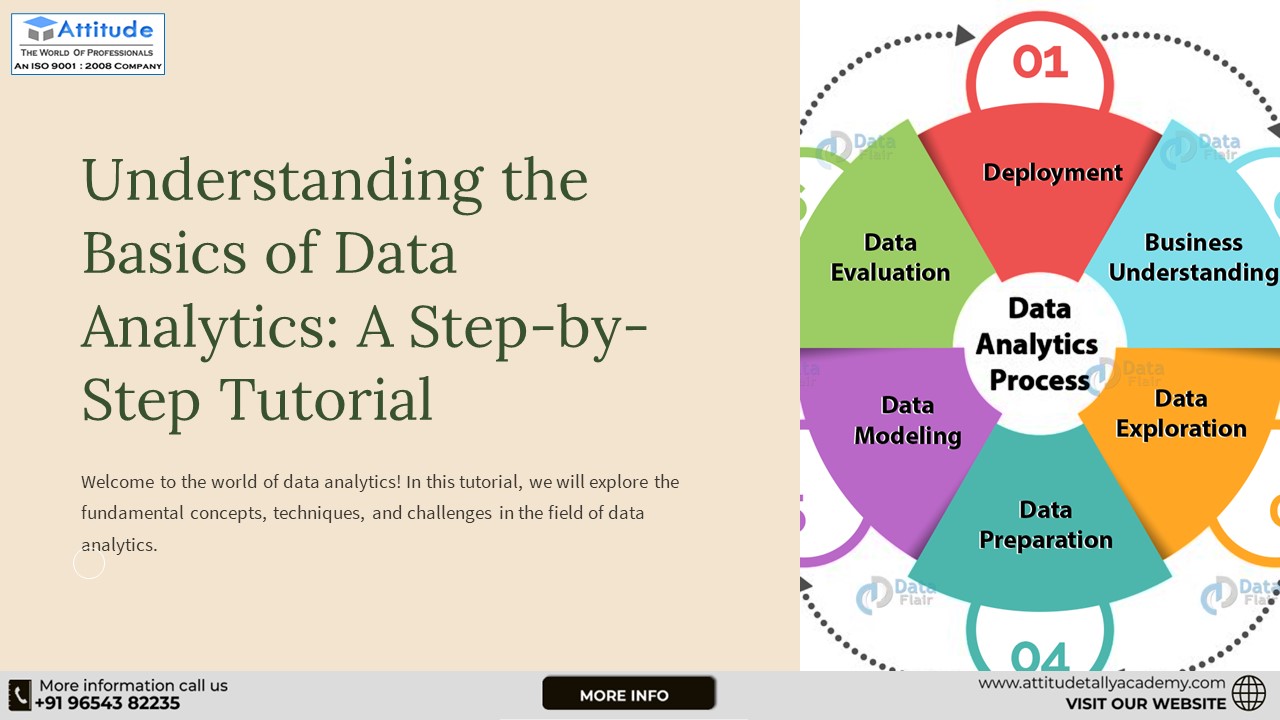Understanding the Basics of Data Analytics PowerPoint PPT Presentation
Title: Understanding the Basics of Data Analytics
1
Understanding the Basics of Data Analytics A
Step-by-Step Tutorial
Welcome to the world of data analytics! In this
tutorial, we will explore the fundamental
concepts, techniques, and challenges in the field
of data analytics.
2
INDEX
- Definition and Importance
- Key Concepts in Data Analytics
- Steps of Data Analytics Process
- Methods and Techniques in Data Analytics
- Challenges and Limitations in Data Analytics
- Conclusion and Next Steps
- FAQ
- Thankyou
3
Definition and Importance
Data analytics is the process of examining large
sets of data to uncover hidden patterns,
insights, and trends. It plays a vital role in
decision making, helping businesses make
data-driven choices to optimize operations and
drive growth.
4
Key Concepts in Data Analytics
1
2
Descriptive, Predictive, and Prescriptive
Analytics
Data Types and Sources
Data can be structured or unstructured, and it
can come from various sources such as databases,
websites, social media, or IoT devices.
Understanding the types and sources of data is
essential for effective analysis.
Data analytics encompasses three main types
descriptive, which focuses on summarizing past
data predictive, which forecasts future
outcomes and prescriptive, which suggests the
best course of action based on analysis.
3
Data Cleaning and Preprocessing
Data needs to be cleaned and preprocessed to
remove inconsistencies, errors, and irrelevant
information. This step ensures the accuracy and
quality of the data before analysis.
5
Steps of Data Analytics Process
1
Defining the Problem
Identify the business problem or question that
data analytics aims to solve. Formulating clear
objectives is crucial for a successful analysis.
2
Data Collection
Gather relevant data from various sources,
ensuring data integrity and reliability. Proper
data collection methods and tools are essential
for obtaining accurate insights.
3
Data Exploration and Visualization
Explore and visualize the data to gain a better
understanding of trends, relationships, and
outliers. Visualization techniques make it easier
to interpret and communicate insights.
4
Data Analysis and Modeling
Apply statistical analysis, machine learning
algorithms, and other data modeling techniques to
extract valuable insights and patterns from the
data.
5
Interpretation and Communication of Results
Interpret the results of the analysis and
communicate them effectively to stakeholders.
Clear and concise reporting ensures actionable
decision-making based on the insights.
6
Methods and Techniques in Data Analytics
Data Sampling and Statistical Analysis
Machine Learning and Artificial Intelligence
Data Mining and Text Analytics
Sampling methods help analyze a subset of data to
infer insights for the entire dataset.
Statistical analysis provides a framework for
making sense of the data and drawing meaningful
conclusions.
Data mining explores large datasets to uncover
patterns, relationships, and trends. Text
analytics focuses on extracting meaningful
insights from unstructured text sources, such as
customer reviews or social media posts.
Machine learning algorithms and AI techniques
enable data analytics applications to learn from
data, detect patterns, and make predictions.
These technologies enhance the efficiency and
accuracy of analysis.
7
Challenges and Limitations in Data Analytics
Data Privacy and Security
Ethical Considerations and Bias
Complexity and Scalability
Protecting sensitive data and ensuring privacy
are critical concerns in data analytics. Adhering
to privacy regulations and implementing robust
security measures are essential.
Data analytics often involves complex algorithms,
computational challenges, and scalability issues.
Adequate infrastructure, tools, and expertise are
necessary to handle large-scale analysis.
Data analytics raises ethical considerations,
such as the responsible use of data and avoiding
biases in analysis. Awareness of biases and
transparency in decision-making are crucial.
8
Conclusion and Next Steps
1
Importance of Continuous Learning
2
Resources for Further Study
Explore books, online courses, webinars, and
industry conferences to deepen your knowledge and
enhance your skills in data analytics. Learning
resources are abundant and readily available.
Data analytics is a rapidly evolving field.
Emphasizing continuous learning and staying
updated with new technologies and techniques is
essential for professionals in the industry.
9
FAQs
Q1 What is Data Analytics, and why is it
important? A1 Data Analytics is the process of
examining raw data to draw conclusions about the
information it contains. It is crucial for
businesses as it enables informed
decision-making, identifies trends, and provides
insights for optimizing processes. Q2 How does
Data Analytics differ from traditional business
intelligence? A2 While business intelligence
focuses on historical reporting, Data Analytics
emphasizes predictive and prescriptive analysis.
It goes beyond summarizing past performance,
using statistical models to forecast future
trends and recommend actions. Q3 What are the
fundamental steps in Data Analytics? A3 The
basics involve data collection, cleaning,
analysis, and interpretation. Understanding the
context, defining objectives, and choosing the
right analytical tools are essential steps to
ensure meaningful insights. Q4 Can anyone learn
the basics of Data Analytics, or is it only for
tech experts? A4 Absolutely! Understanding the
basics of Data Analytics is accessible to
everyone. Many resources, online courses, and
tools cater to beginners, providing a
user-friendly introduction to the concepts and
techniques involved.
10
(No Transcript)

